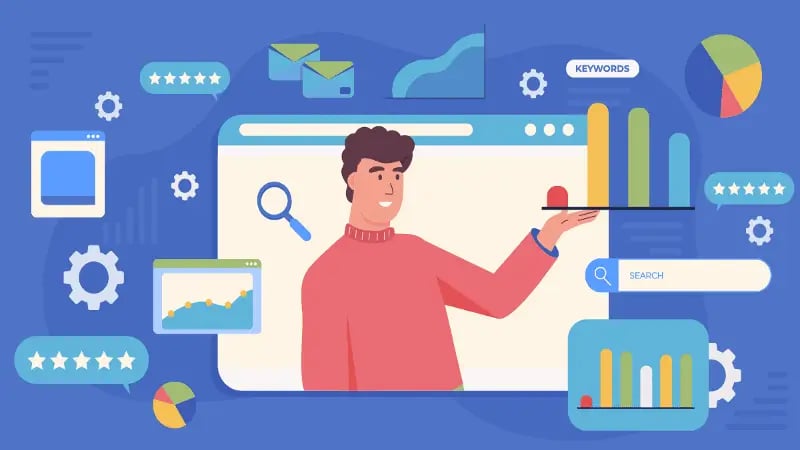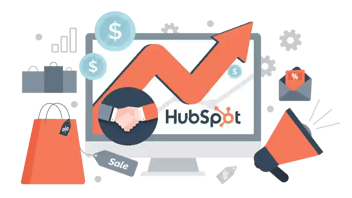The Key to SaaS Sales Growth: A Strong Sales Enablement Framework
Achieving consistent revenue growth in software as a service (SaaS) sales requires more than just occasional sales training. You need strategies like sales enablement to give sellers the tools and skills they need to sell more effectively.
The right sales enablement framework assists SaaS sales teams in addressing challenges, keeping prospects engaged, and maximizing their conversion and sales rates.
The Importance of Sales Enablement in SaaS
Sales enablement refers to business-focused frameworks that are designed to assist sales teams with their day-to-day operations. Strong frameworks can help teams maintain consistent sales performance despite the constant flux of their industries, sectors, and target audience preferences.
In 2025, economic factors, the buying environment, and the transformation of sellers' roles are all driving rapid changes in the realm of SaaS sales. Sales enablement is designed to give sales teams the tools, knowledge, and resources they need to adapt to these shifts and sell software more effectively.
These frameworks' applications extend far beyond providing information and tools to sales professionals. The right framework can also actively aid organizations in building a culture of sales enablement within their ranks.
This culture ensures that every member of a SaaS business, including sales professionals, leaders, and members of other departments, is dedicated to maximizing the performance of sales functions.
Overall, sales enablement is proving so effective for revenue generation that it's now among the three leading tactics sales leaders use to drive growth.
The Contents of Sales Enablement Frameworks
According to Phil Gray, COO at Black & White Zebra, "Sales enablement is the process of equipping and training sales leaders to sell more effectively. It's all about arming your team with the right tools, resources, and knowledge they need to close more deals."
Sales enablement frameworks usually provide these tools, knowledge, and resources through sales enablement content. This content can take many forms, from case studies and white papers to value-added blog posts, sales playbooks, product sell sheets, and informational videos.
Some frameworks also include content like testimonials, eBooks, webinars, sales presentations, and optimally structured sales proposals.
This content lays the groundwork for effective sales team training and allows them to improve their use of technologies and key sales processes. When implemented strategically, this education and training can have significant impacts on SaaS organizations.
Hubspot's State of Sales 2024 report highlights that sales professionals who use sales enablement content are 58% more likely to surpass their sales targets than their peers. It's unsurprising that the associated budgets are expected to increase by 50% between 2023 and 2027.
The Benefits of Sales Enablement Frameworks for SaaS Sales Growth
Sales enablement offers significant benefits for SaaS sales performance, revenue growth, and overall organizational efficiency. Its key benefits include:
1. Enabling Teams to Close More Deals
Sales enablement frameworks are designed to give sales representatives the tools they need for selling success. When they have the tools, knowledge, and skills they need to sell at a consistently high level, they will be able to close more deals.
Data shows that businesses with frameworks in place have an average 49% win rate on their forecasted deals. By contrast, organizations without have a win rate of just 42.5%. It's also noted that effective related training programs have supported 84% of sales reps in achieving their quotas.
2. More Efficient Sales Processes
When the right processes and tools are in place, sales teams find it easier to work productively and to the best of their ability. Data access creates more capable and efficient teams. This, in turn, leads to higher returns on investments for sales activities and more revenue generated.
Sales enablement frameworks with onboarding programs can contribute greatly to operational efficiency. According to statistics from G2, sales onboarding programs can assist new sales reps in becoming productive at work up to 3.4 months sooner. This time-to-productivity ratio is as much as 37% quicker than firms with ineffective onboarding programs in place.
3. Better Sales and Marketing Collaboration
When teams have access to sales enablement frameworks, they can effectively align their strategies, goals, campaigns, and roles with your SaaS company's marketing teams. This collaboration can create seamless connections between marketing and sales. The result: more conversions and more sales.
Imagine a SaaS organization aligning its marketing lead generation campaigns with its sales outreach efforts. This alignment creates a more strategic and coordinated approach. This approach assists the organization in generating leads and leading them through the sales funnel. This optimized process ultimately results in more paying clients and higher revenues.
4. Improving Forecasting
A considerable number of sales teams don't accurately forecast their sales pipelines. The primary reason for this is weak sales processes. Teams that cannot accurately predict their future revenues and quota fulfillment are effectively working in the dark.
Sales enablement could be the key to improving your sales teams' forecasting abilities. The right programs and frameworks use proven sales processes and engagement tools along with data analytics to markedly improve forecast accuracy. This, in turn, can compound sales performance. It also assists teams in creating more consistent and predictable revenue streams.
5. Enhancing Client Satisfaction
Your clients are the cornerstones of your success as a SaaS organization. Without them, sales simply wouldn't be possible. By training your sales teams with a strong sales enablement framework, you can ensure that they are well-equipped to meet your client's needs at all times.
Well-trained professionals can offer prospects the right solutions at the right price points and times in the customer journey. This can notably improve customer satisfaction. This satisfaction has benefits for client retention and long-term revenue generation as well.
G2 reports that 80% of customers note that the experience a business provides is as important as its services and products. In light of this, offering your clients a strong sales experience is the key to lasting engagement.
An even greater 89% of clients make purchases based on the sales experience, regardless of functionality or pricing. Enhancing your customer experience with sales enablement will help you take advantage of these trends.
Sales Enablement Implementation Best Practices
Use these best practices to implement a strong sales enablement framework for your SaaS organization:
-
Keep it simple: Choose a framework that provides content in formats that are easy for your teams to access, understand, and digest.
-
Implement training: Provide training on using your specific framework. This training will help your team make the best use of the tools available to them.
-
Explain the process: Ensure that all your sales reps understand sales enablement. They should have a solid understanding of its processes and how it can streamline sales activities.
-
Seek feedback: Establish follow-up meetings to check in with sales reps and gain feedback about the framework and tools they are using.
-
Promote personalization: Provide reps with access to client data to enable them to personalize their sales pitches. Doing so helps to create a connection with the target audience and improve conversions.
-
Establish roles: Define clear roles and responsibilities for all reps involved in sales enablement processes. By clarifying expectations, you can ensure everyone remains on the same page and coordinates their activities to drive sales success.
-
Use onboarding software: Use a sales onboarding tool to provide new sellers with a memorable and informative onboarding process.
-
Provide ongoing training and enablement through your framework: Market conditions, client expectations, competitors, and products are constantly changing. Onboarding is not always enough to prepare your sales reps to effectively engage and sell to prospects over time. Provide detailed, ongoing sales training to keep your teams up to date with the latest sales best practices.
-
Prioritize verbal clarity in sales interactions: Ensure that sales reps can communicate clearly, avoid jargon, and tailor their messaging to different audiences. The use of clear, concise speech builds trust, reduces misunderstandings, and improves conversions.
-
Consider AI-based enablement tools: AI sales enablement programs can suggest content to sellers based on individual prospects' behaviors and preferences. These AI programs can help them to adopt more personalized sales approaches based on each prospect's needs and goals.
-
Choose a strategy for measuring efficacy: Track key performance indicators and metrics to determine the impacts your implemented system is creating. The metrics you track will depend on your organization's unique objectives. SaaS businesses often use win rate, quota attainment, time-to-revenue, and customer satisfaction KPIs to gauge success.
-
Optimize your framework regularly: A sales enablement framework is a dynamic tool. It should change as your selling strategies, target audiences, and clients evolve. Use data and feedback from clients and sales reps to optimize your framework. This will ensure it remains relevant to your organization and sales teams' needs.
Unlocking SaaS Sales Growth with Sales Enablement
Your sales enablement framework is invaluable for driving SaaS sales growth, sales team performance, and client satisfaction. Equipping your sales professionals with the right tools can unlock their potential, maximize your sales and revenue growth, and build lasting trust and connections with your organization's customers.
The key to successfully implementing your framework is to evaluate it consistently and update it regularly. Sales is a constantly shifting field, and your strategy needs to be flexible to keep up with this flux. Assess your framework frequently and use client data, feedback from your reps, and industry best practices to ensure your organization can actively adapt to your prospects' needs.
Are you ready to give your SaaS organization the foundation it needs for success in sales?
Aspiration Marketing's team of experts can help you streamline every level of your strategy. Our specialists can perform needs analysis for your business, create a comprehensive sales enablement framework based on your objectives, and implement sophisticated tools to supercharge your sales.
This content is also available in:
- German: SaaS-Wachstum: Das starke Sales Enablement Framework
- Spanish: Crecimiento de ventas SaaS: el marco de capacitación
- French: Croissance des ventes SaaS: le cadre d'aide à la vente
- Italian: Crescita vendite SaaS: la struttura di abilitazione
- Romanian: Creșterea vânzărilor SaaS: cadre de abilitare eficiente
- Chinese: SaaS 销售增长的关键:强大的销售促进框架

Opinions expressed in this article are those of the guest author. Aspiration Marketing neither confirms nor disputes any of the conclusions presented.









Leave a Comment